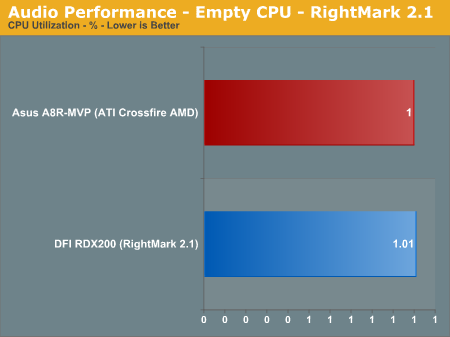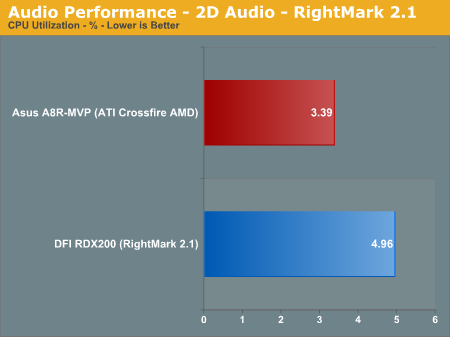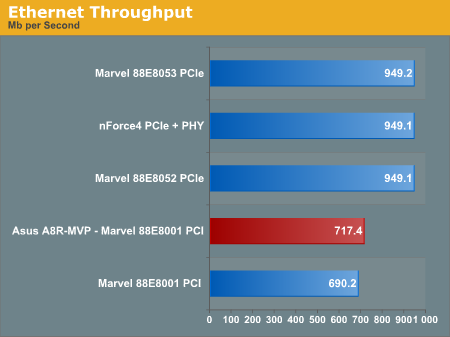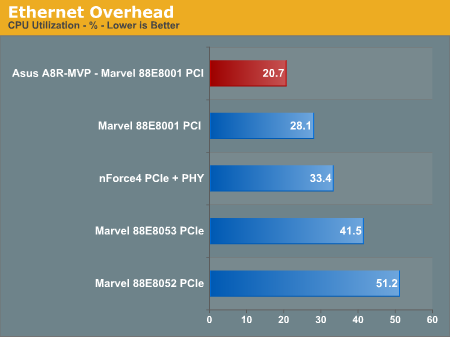Asus A8R-MVP: Mainstream Rocket
by Wesley Fink on November 23, 2005 1:15 AM EST- Posted in
- Motherboards
Audio Performance
For audio testing, we used Rightmark 3D Sound CPU utilization test, which is the same benchmark run in our earlier nForce4 SLI and Ultra roundups. This benchmark measures the overhead or CPU utilization required by a codec or hardware audio chip. We tested performance using the latest version 2.1. Since we found that Version 2.1 yields different results from the earlier 1.24, we have only included test results with version 2.1.
It is very important to point out that the ATI chipset motherboards have the necessary hooks to deliver Azalia High Definition audio. Those who have been complaining about the poor AC'97 audio present on most AMD boards should be very pleased to find Azalia HD on the ATI chipset boards. The nForce4 family does not offer the necessary chipset hooks to support HD Azalia audio.
Ethernet Performance
The one area where the Asus A8R-MVP is mildly disappointing is in their choice of an Ethernet controller. Instead of using a PCIe LAN that is capable of providing full 1 Gb bandwidth, Asus used a PCI solution that will be limited in maximum speed by the PCI bus. In practical terms, the PCI bus caps out about 700 Mb/s compared to the 950Mb/s capability of a 1 Gigabit PCIe solution. Since most broadband Ethernet connections barely tax 10Mb/s, this really only matters to those who do sustained high-speed transfer of very large files over a true 1Gb network - probably less than 1% of users. Still, you should be aware that PCIe Gigabit Ethernet is always a better solution.
The Windows 2000 Driver Development Kit (DDK) includes a useful LAN testing utility called NTttcp. We used the NTttcp tool to test Ethernet throughput and the CPU utilization of the various Ethernet Controllers used on the AMD motherboards.
We set up one machine as the server; in this case, an Intel box with an Intel CSA Gigabit LAN connection. Intel CSA has a reputation for providing fast throughput and this seemed to be a reasonable choice to serve our Gigabit LAN clients. At the server side, we used the following Command Line as suggested by the VIA whitepaper on LAN testing:
For audio testing, we used Rightmark 3D Sound CPU utilization test, which is the same benchmark run in our earlier nForce4 SLI and Ultra roundups. This benchmark measures the overhead or CPU utilization required by a codec or hardware audio chip. We tested performance using the latest version 2.1. Since we found that Version 2.1 yields different results from the earlier 1.24, we have only included test results with version 2.1.



It is very important to point out that the ATI chipset motherboards have the necessary hooks to deliver Azalia High Definition audio. Those who have been complaining about the poor AC'97 audio present on most AMD boards should be very pleased to find Azalia HD on the ATI chipset boards. The nForce4 family does not offer the necessary chipset hooks to support HD Azalia audio.
Ethernet Performance
The one area where the Asus A8R-MVP is mildly disappointing is in their choice of an Ethernet controller. Instead of using a PCIe LAN that is capable of providing full 1 Gb bandwidth, Asus used a PCI solution that will be limited in maximum speed by the PCI bus. In practical terms, the PCI bus caps out about 700 Mb/s compared to the 950Mb/s capability of a 1 Gigabit PCIe solution. Since most broadband Ethernet connections barely tax 10Mb/s, this really only matters to those who do sustained high-speed transfer of very large files over a true 1Gb network - probably less than 1% of users. Still, you should be aware that PCIe Gigabit Ethernet is always a better solution.
The Windows 2000 Driver Development Kit (DDK) includes a useful LAN testing utility called NTttcp. We used the NTttcp tool to test Ethernet throughput and the CPU utilization of the various Ethernet Controllers used on the AMD motherboards.
We set up one machine as the server; in this case, an Intel box with an Intel CSA Gigabit LAN connection. Intel CSA has a reputation for providing fast throughput and this seemed to be a reasonable choice to serve our Gigabit LAN clients. At the server side, we used the following Command Line as suggested by the VIA whitepaper on LAN testing:
Ntttcps -m 4,0,‹client IP› -a 4 -l 256000 -n 30000On the client side (the motherboard under test), we used the following Command Line:
Ntttcpr -m 4,0,‹server IP› -a 4 -l 256000 -n 30000At the conclusion of the test, we captured the throughput and CPU utilization figures from the client screen.












74 Comments
View All Comments
Wesley Fink - Friday, December 9, 2005 - link
The PCIe giagbit cards should deliver the same performance as on-board PCIe Gigabit Ethernet. They generally use the same chips as on-board or variants f those chips. You can use the x1 PCIe slot with Crossfire IF your cards are single width. If the video cards are double width the PCIe x1 is blocked.We have a Syskonnect PCIe Gigabit Ethernet card and it uses the Marvel 88E8052 chip.
Ryan Norton - Monday, December 5, 2005 - link
...just wrote them basically begging for availibility info on this board. Anand's article has gotten me very very hyped for this product as a cheap SLI replacement for my MSI Neo4 Ultra -- HALF the price of an A8N32 seems like it can't be beat. For all that's worth, however, I still haven't found a single user experience with this board -- have the lucky people who have it (if there are any) forgotten about the internet?imaheadcase - Thursday, December 8, 2005 - link
It is now in stock at neweggYellowWing - Monday, November 28, 2005 - link
This board looks good for a HTPC, but I have one question about the HD audio, you do not mention if this board will do a real time encode of Dolby Digital on that coaxial SPDIF port. My minimum requirements for a HTPC main board include passive cooling and Dolby Digital out either optical or coaxial to connect with my home theater receiver. I would appreciate a standard line in each motherboard review that makes the Dolby Digital out capability of each main board clear.Keep up the great work.
imaheadcase - Monday, November 28, 2005 - link
Man all these sweet deals at newegg but don't have this board yet :(ElFenix - Saturday, November 26, 2005 - link
thanks for all the updates, wes!rjm55 - Friday, November 25, 2005 - link
This looks like the perfect Socket 939 board. It's fast, passive-cooling, great overclocker, and cheap!! Even uses the ATI chipset and is built by the biggest board maker in the world, so how could I go wrong. Just put 2 on order at Buy.com. At $105 each they seemed like a perfect board for some Christmas builds.Zebo - Saturday, November 26, 2005 - link
Is'nt most of chipset in AMD CPU these days? I would'nt worry about that.xsilver - Thursday, November 24, 2005 - link
does asus ship this board with overclocking software for overclocking while booted in windows? what other mobo companies offer this? (I find this feature very handy on my abit)its most convienient to boot up and surf and run stock speeds and then overclock to play a game and then change back when you're finished
I know utilities like rmclock and cpucool can do this but they dont work for all mobo's
Wesley Fink - Thursday, November 24, 2005 - link
Yes, Asus includes some very good windows-based OC software with the A8R-MVP. AI Booster allows the control of OC in windows, and PC Probe 2 allows fan control and voltage/temperature monitoring. AMDZone descibes these software utilities in their A8R-MVP preview at http://www.amdzone.com/modules.php?op=modload&...">http://www.amdzone.com/modules.php?op=m...q=viewar...